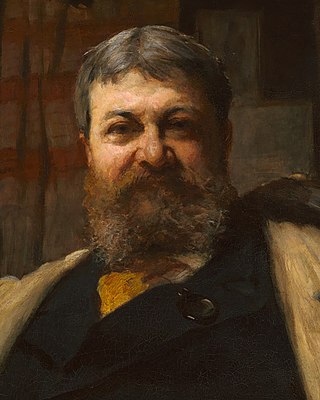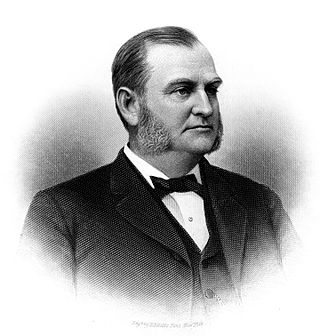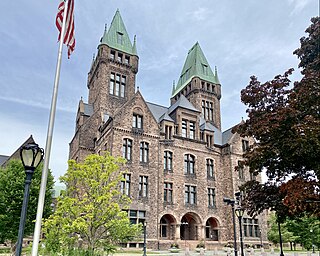
Easton is a town in Bristol County, Massachusetts, United States. The population was 25,058 at the 2020 census. It is part of the Greater Boston area.

Henry Hobson Richardson, FAIA was an American architect, best known for his work in a style that became known as Richardsonian Romanesque. Along with Louis Sullivan and Frank Lloyd Wright, Richardson is one of "the recognized trinity of American architecture".

Oliver Ames was an American businessman, investor, philanthropist, and Republican politician who served as the 35th Governor of Massachusetts from 1887 to 1890.

Calvert Vaux FAIA was an English-American architect and landscape designer, best known as the co-designer, along with his protégé and junior partner Frederick Law Olmsted, of what would become New York City's Central Park.

Oliver Ames Jr. was president of Union Pacific Railroad when the railroad met the Central Pacific Railroad in Utah for the completion of the First transcontinental railroad in North America.

The Richardson Olmsted Campus in Buffalo, New York, United States, was designated a National Historic Landmark in 1986. The site was designed by the American architect Henry Hobson Richardson in concert with the famed landscape team of Frederick Law Olmsted and Calvert Vaux in the late 1800s, incorporating a system of enlightened treatment for people with mental illness developed by Dr. Thomas Story Kirkbride. Over the years, as mental health treatment changed and resources were diverted, the buildings and grounds began a slow deterioration. In 2006, the Richardson Center Corporation was formed to restore the buildings.

The Rockery, also known as the Memorial Cairn, is an unusual war memorial designed by the noted American landscaper Frederick Law Olmsted. It is located at the center of North Easton Center in Easton, Massachusetts, where it forms the focal point for two adjacent H. H. Richardson buildings with their own Olmsted landscapes.

National Park Service rustic – sometimes colloquially called Parkitecture – is a style of architecture that developed in the early and middle 20th century in the United States National Park Service (NPS) through its efforts to create buildings that harmonized with the natural environment. Since its founding in 1916, the NPS sought to design and build visitor facilities without visually interrupting the natural or historic surroundings. The early results were characterized by intensive use of hand labor and a rejection of the regularity and symmetry of the industrial world, reflecting connections with the Arts and Crafts movement and American Picturesque architecture.
Shepley, Rutan and Coolidge was a successful architecture firm based in Boston, Massachusetts, United States, operating between 1886 and 1915, with extensive commissions in monumental civic, religious, and collegiate architecture in the spirit and style of Henry Hobson Richardson.

The Ames Free Library is a public library designed by noted American architect Henry Hobson Richardson. It is located at 53 Main Street, Easton, Massachusetts, immediately adjacent to another Richardson building, Oakes Ames Memorial Hall.

Oakes Ames Memorial Hall is a historic hall designed by noted American architect H. H. Richardson, with landscaping by Frederick Law Olmsted. It is located on Main Street in the village of North Easton in Easton, Massachusetts, immediately adjacent to another Richardson building, Ames Free Library.

Oakes Angier Ames was an American businessman, investor, and philanthropist in the Ames family of North Easton, Massachusetts.
Francis ("Frank") R. Kowsky is a notable architectural historian and State University of New York (SUNY) Distinguished Professor of Fine Arts at Buffalo State College, SUNY, Buffalo, New York. He has published on nineteenth-century American architects and architecture including Frederick Withers, Calvert Vaux, and H. H. Richardson, as well as the architecture and landscape of Buffalo and northwestern New York State. He is also active in historic preservation and has served on the New York State Board for Historic Preservation, the Board of Directors of the Preservation Coalition of Erie County, New York, and is currently a trustee of the National Association for Olmsted Parks.

The North Easton Historic District is a historic district in Easton, Massachusetts encompassing a cohesive village area developed in the late 19th and early 20th centuries, primarily through the activities of the locally important Ames family. The district was added to the National Register of Historic Places in 1972. In 1987, a portion of the district was designated a National Historic Landmark District, known as the H. H. Richardson Historic District of North Easton, which includes several buildings designed for the Ameses by architect H. H. Richardson.

The F. L. Ames Gardener's Cottage is a small residential house in North Easton, Massachusetts. This building was designed in 1884 by noted American architect Henry Hobson Richardson and built the following year. This building sits on the original Ames estate and was designed soon after the neighboring Ames Gate Lodge. Frederick Lothrop Ames also commissioned Richardson to build the nearby Old Colony Railroad Station. Two other notable buildings in North Easton, the Ames Free Library and Oakes Ames Memorial Hall, were also Richardson designs and commissioned by the Ames family.

The H. H. Richardson Historic District of North Easton is a National Historic Landmark District in the village of North Easton in Easton, Massachusetts. It consists of five buildings designed by noted 19th-century architect Henry Hobson Richardson, and The Rockery, a war memorial designed by Frederick Law Olmsted. It was declared a National Historic Landmark in 1987.

The Ames Shovel Shops, also known as Ames Shovel Works or Ames Shovel Shop, is a historic 19th century industrial complex located in North Easton, Massachusetts. It is part of the North Easton Historic District, and consists of several granite buildings constructed between 1852 and 1885, along with several newer additions and outbuildings dating to about 1928.

The Architecture of Buffalo, New York, particularly the buildings constructed between the American Civil War and the Great Depression, is said to have created a new, distinctly American form of architecture and to have influenced design throughout the world.

North Easton station is a former railroad station designed by noted American architect H. H. Richardson. It is located just off Oliver Street in North Easton, Massachusetts, and currently houses the Easton Historical Society. The station was built in 1881 and served commuter trains until 1958. It was added to the National Register of Historic Places in 1972 as Old Colony Railroad Station. In 1987, it also became part of the H. H. Richardson Historic District of North Easton, a National Historic Landmark District. The proposed Phase 2 of South Coast Rail would return commuter rail service to the location in 2030 as Easton Village station.

Frederick Lothrop Ames was heir to a fortune in railroads and shovel manufacturing. He was Vice President of the Old Colony Railroad and director of the Union Pacific railroad. At the time of his death, Ames was reported to be the wealthiest person in Massachusetts.





















